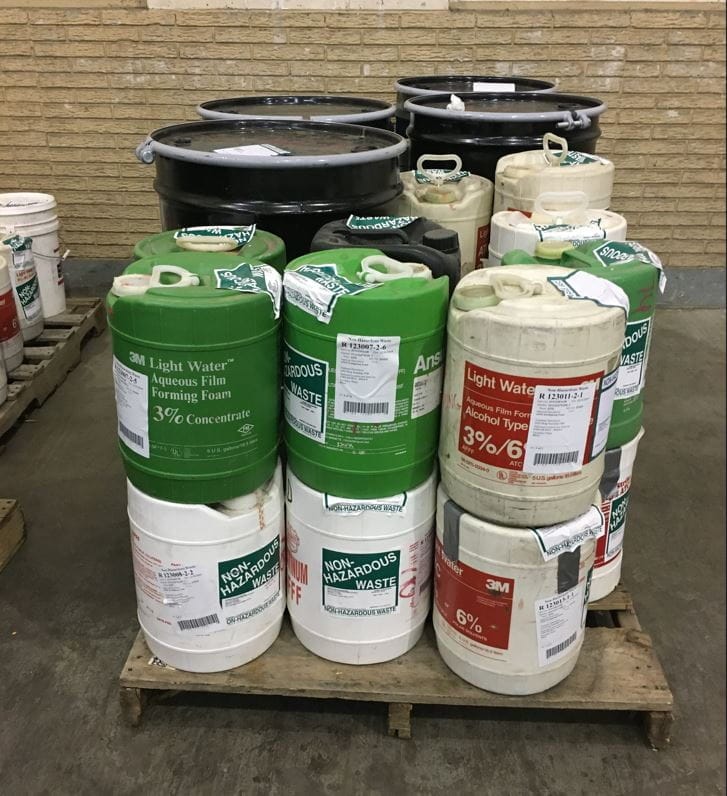Welcome to ContamiNation. Subscribe for free to receive it monthly.
Class B firefighting foam, a massive source of per- and polyfluoroalkyl substances (PFAS) contamination, remains a threat to many communities—stored in jugs, totes and tanks at fire departments, airports, petroleum and chemical facilities, ports and former military bases. A preliminary estimate of the foam concentrate being gathered in 16 state takeback programs already exceeds 500,000 gallons.
Known as aqueous film-forming foam (AFFF or “A-triple-F”), these chemical concentrates—when mixed with water—generate a smothering foam that deprives combustible fuel fires of oxygen. The U.S. Navy and 3M developed the first fluorinated foam in the mid-1960s, and AFFF formulations were widely used on fires and in training exercises for more than half a century.
PFAS contamination in groundwater and ecosystems from AFFF began surfacing in 1999, but only now are efforts accelerating to end its use and get rid of remaining stocks. The military is phasing out foams containing PFAS, following pressure from Congress, and airports no longer require AFFF use. Thirteen states have banned the sale of AFFF while others have eliminated its use in fire training and have mandated reporting of AFFF incidents.
States face a complex challenge working to determine where remaining AFFF stocks are, how to store and get rid of the chemicals, what to select for alternatives, and how to help firefighters decontaminate equipment of residual PFAS.
States face a complex challenge working to determine where remaining AFFF stocks are, how to store and get rid of the chemicals, what to select for alternatives, and how to help firefighters decontaminate equipment of residual PFAS.
Disposal or destruction
Earlier this month, the U. S. Environmental Protection Agency issued updated guidance on disposal and destruction options for materials containing PFAS, but many of the permitted choices risk transferring the highly persistent chemicals between media and locations.
Transporting AFFF to deep injection wells or hazardous waste facilities in other states can endanger groundwater and exacerbate environmental injustices (as reported by Wisconsin Watch and AL.com). Incineration may not fully break down PFAS, risking emissions that can travel significant distances. After reconsidering its initial decision to incinerate AFFF stocks, Washington State spent two years assessing the environmental impacts of different options. The rapid pace of PFAS research and technology can complicate states’ plans to implement an AFFF strategy.
Two technologies being piloted with AFFF now claim to effectively destroy its strong carbon-fluorine bonds. One method, Supercritical Water Oxidation, involves extremely high heat (from 374°C up to 575°C for some PFAS compounds) and pressurized water. This technique is being refined in several U.S. settings, and a new plant in Columbus, Ohio plans to treat AFFF stocks gathered from Ohio and from New Hampshire. Another method, Hydrothermal Alkaline Treatment (HALT), which combines high temperatures and pressure with alkaline chemicals, is undergoing field testing.
Aided by software
North Carolina, a state at the forefront of PFAS research, is taking a strategic approach to its AFFF takeback program that could help other states navigate this challenging transition.
Its Office of the State Fire Marshal piloted an online software program to manage its AFFF inventory. Within a year, the state attained 100 percent participation—a notable success, says State Fire Marshal Brian Taylor, considering that the Office typically gets a 10 percent written return rate (more than two-thirds of the state’s fire departments are staffed by volunteers).
To ensure complete participation, the Fire Marshal’s office issued clear guidance and got “boots on the ground,” Taylor says, providing several regional resource people who could help local departments compile critical information. The initial inventory located 125,000 gallons of AFFF at hundreds of fire departments across the state.
Fire departments report incidents involving AFFF use on the online application as well. Having the inventory allows Taylor’s office to catch any AFFF use not reported and to educate departments that don’t yet understand “what [AFFF] should be used for, and when it should be used,” he says. The system will also help gather data for a water quality investigation the North Carolina Department of Environmental Quality is planning near fire departments and training areas.
Many fire marshals’ offices already use the same “ImageTrend” incident-reporting software that North Carolina has, Taylor says, so other states can access the new applications for AFFF management at no added cost.
New Hampshire undertook its state inventory before any such online tool was available, says Andrew Gould, a program manager with the state’s Department of Environmental Services, and he acknowledges that calling every town to get inventory details was time-consuming. For the takeback of foam, New Hampshire will rely on an online system set up by the contractor to confirm the amounts of AFFF collected.
The long road to replacement
Environmental scientists at NC State and Duke University plan to chemically analyze each container of AFFF the state collects, “fingerprinting” the contents in case of contamination found in the future linked to AFFF use. Their analysis will also help identify foams that came from the military (which donated surplus AFFF to municipal fire departments).
Following the collection of AFFF from local departments, research collaborators may undertake a “head-to-head” comparative analysis to test the efficacy of different AFFF destructive methodologies, a test that could generate data valuable to all states, explains Jeffrey Warren, executive director of the NC Collaboratory, a center at UNC Chapel Hill created to strengthen scientific partnerships and foster the research needed for sound policy-making.
There’s a growing selection of fluorine-free foams (known as “F3”) available to replace AFFF, several dozen of which have undergone “GreenScreen” certification by the nonprofit Clean Production Action, which works to ensure that new formulations are free of health and ecological hazards. The Foam Exposure Committee, a group dedicated to educating fire departments, has a shorter list of F3 products that have undergone independent total fluorine testing with fire test certifications, according to its co-chair Vicki Quint.
The foam conversion process is complicated by the need to decontaminate all equipment that previously held fluorinated foam. Simple water rinses are not adequate and can generate PFAS-contaminated water that requires treatment. A summary report prepared for Connecticut’s AFFF takeback program captures the complexity of this final step in the transition.
Colorado is helping local fire departments cover foam replacement costs by buying back AFFF at $40/gallon through a program funded by a tax on tanker fuel transport. The state also offers a PFAS grants program that helps public water systems, private well owners and local governments (potentially including fire departments) sample waters for contamination, including those affected by past AFFF use.
Across the nation, far more support is needed to help local fire departments transition from AFFF, Quint says. She applauds state initiatives but says there is no coordination among them and no leadership from federal entities like the U.S. Fire Administration. Except for her committee’s bulletins, few communications about AFFF and replacements go to local fire departments, she adds: “We’re a community that’s not really being addressed.”
News of Note
Big announcements from the U.S. Environmental Protection Agency (EPA) dwarfed other recent PFAS news. First, the EPA set final standards to limit PFAS in drinking water, the first legally enforceable contaminant limits put in place since the Safe Drinking Water Act was amended in 1996. The maximum contaminant level (MCL) for PFOA and PFOS, commonly found eight-carbon compounds, is now 4 parts per trillion (ppt), what the Environmental Protection Agency deemed “the lowest levels that are feasible for effective implementation.” The MCL for PFNA, PFHxS, and “GenX chemicals” is set at 10 ppt. States will face big and costly changes adapting to this standard, as will water utilities. The EPA estimates added costs for filtration at $1.5 billion/year after the initial capital investments, but the American Water Works Association puts that figure closer to $4 billion.
Today the EPA announced a final rule making two legacy PFAS compounds (no longer manufactured in the U.S. but ubiquitous in the environment), PFOA and PFOS, hazardous substances under the Superfund Law (technically CERCLA, the Comprehensive Environmental Response, Compensation and Liability Act). This law mandates investigation and cleanup of hazardous sites (with the associated costs falling on those responsible for the contamination). Importantly, EPA set an “enforcement discretion and settlement policy” regarding PFAS that allows the agency to focus on the primary manufacturers and users of PFAS, not all the entities caught contending with PFAS they had no hand in creating (such as water districts, wastewater utilities, airports, fire departments and farmers).
Given a dearth of solid data to guide policy choices for both PFAS and microplastics, it’s encouraging to see more funds flowing toward scientific research. Maine will receive $17 million in federal funding to improve agricultural research on PFAS at a new lab and center run in cooperation with the U.S. Department of Agriculture’s Agricultural Research Service. And the Rochester Institute of Technology is launching a center for studying microplastics and human health with $7.3 million in federal funding.
Good Resources
If the main story in this issue piqued your interest about technologies being developed to break apart the tenacious carbon-fluorine bonds in PFAS, read Britt Erickson’s recent piece in Chemical and Engineering News, “Competition to destroy ‘forever chemicals’ heats up.” It’s encouraging to learn that alongside the competition, there’s a fair amount of collaboration happening among tech companies working on this challenge.
For those in search of data on harmful chemical releases, there’s a new tool—Fencelinedata.org—that synthesizes federal databases to offer more accessible information about facility-level releases of greenhouse gas emissions and toxic chemicals, as well as environmental violations.
Good Riddance
Recent press has drawn attention to the “greenwashing” of detergent pods and laundry sheets. Marketed as earth-friendly, these products contain polyvinyl alcohol (PVA or PVOH), a water-soluble plastic that has turned up in drinking water (alongside other microplastics). An easy subsitute is concentrated powders packaged in paper or cardboard. To avoid a host of other chemicals you might not want in your laundry or dishwasher powder, review recommendations from the Mamavation site, which has products lab-tested for specific hazardous ingredients. Then choose a brand not packaged in plastic.
Thanks for reading!






As a former small-town firefighter I can attest to this being a huge issue. When I organized any drills involving foam, I substituted dish detergent to avoid using AFFF. I didn't know about PFAS at the time but I knew there were dangerous contaminants in firefighting foam.